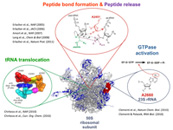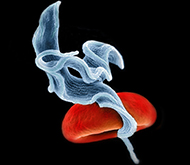Projects
Atomic mutagenesis of the ribosome
The most abundant ncRNA class in the cell are the ribosomal RNAs (rRNA) that are integral parts of the ribosome. Ribosomes are multifunctional ribonucleoprotein (RNP) complexes that translate the genome's message into proteins needed for life in every living cell. As they are so fundamental to life and represent one of the main targets for antibiotics, comprehending how they work is at the heart of molecular understanding of biology. Decades of biochemical, genetic and recent crystallographic studies compellingly revealed the ribosome as an RNA-enzyme. This places the ribosome as key entry on the list of naturally occurring ribozymes that outlived the transition from the pre-biotic ‘RNA World’ to contemporary biology. From an evolutionary point of view it is fascinating that the modern ribosome, so to say the mother of all protein enzymes, still relies on RNA catalysis.
In prokaryots, ribosomes are ~ 2.5 MDa large complexes that are composed of two unequal subunits, the small 30S subunit and the large 50S subunit. The ribosomal peptidyl transferase center is the catalytic heart of the ribosome and plays a fundamental role in protein synthesis. Based on biochemical, genetic and structural data, several catalytic models have been proposed. The level of chemical engineering that can be achieved by conventional mutagenesis, however, turned out to be inadequate to gain comprehensive molecular insight into ribosome-mediated reactions. This is mainly due to the fact that at any particular rRNA position, it is limited to only three possible mutations that can be incorporated by RNA polymerase. To overcome these limitations we have established an in vitro assembly approach that allows the incorporation of non-natural nucleoside analogs at desired positions of 23S rRNA in the T. aquaticus large ribosomal subunit. This tool allows manipulating single functional rRNA groups or even individual atoms within the ribosome. By applying this atomic mutagenesis approach we have obtained unprecedented functional insight into peptide bond synthesis, peptide release, ribosome-triggered activation of translational GTPases, and tRNA translocation (Figure 1).

Click figure to enlarge

